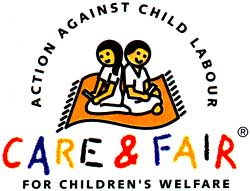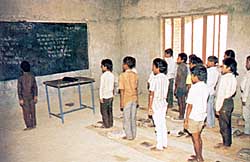Rug Weaving and Child Labor
Since the 1920's we've traveled regularly to weaving areas throughout the Middle East. These days we make two or three month-long trips each year. There are two basic reasons for all this travel on our part:
- The nearer we get to the loom, the less we pay for the rug.
- By traveling to the weaving village we get to see exactly who is making the rug, and we have the chance to inspect the quality of the materials they're using.
In many ways, this second reason is more important than the first.
Americans who have never traveled beyond Europe are sometimes surprised to learn that items like labor unions, the 40 hour work week, and government-sponsored unemployment insurance are recent Western inventions. Most of the people in the world still live in agrarian societies much like the America of the 1820's and 30's. As in 19th Century America, people in most of today's agrarian societies face a life of physical labor as subsistence farmers. Crops are planted by hand, harvested by hand, and processed and stored for local consumption. Families produce as many daily necessities themselves as they can; others can be bartered for in the nearby village. Cash is always difficult to earn. If you have a bumper rice crop this year, so does everyone else in your whole district: you can't sell your surplus to your neighbor because he has as much extra rice as you do.
In most rug making areas, weaving is a way for a farming family to produce a product which they can sell for cash. If you're a good weaver, it doesn't matter how many other people in your village make rugs: there will still be a cash market for your rug because it is better made than the rest.
The rub in this whole scheme for us in the West is that in these areas children are almost always expected to work alongside their parents to contribute to the support of the family (in the same way that farm kids in the US have always been expected to help with the chores). Kids do jobs appropriate to their ages. Younger children watch after the sheep or goats; older children help in the fields with whatever work needs to be done. Even basic government schools usually cost money for materials, and fancier schools cost money for admission fees, uniforms, and books. Rarely is there the money to send children to school, and besides, they're needed to help do the family's work.
Child Labor
Some of the work children help with is carpet weaving. Although in a completely beneficent world anyone would prefer to see children everywhere in the world have a Western-style childhood with the opportunity for a sophisticated education, we do not see child labor within the family unit as a horrible thing ("within the family unit" is the crucial phrase). Weaving learned from a mother, grandmother, father or brother is a specialized skill which can produce a cash income for the weaver and the family. If the choice is between stoop labor in the fields and weaving, there is no question but that weaving is by far the better life. For years we've supported the "Care & Fare" program organized in India to oversee child labor and provide at least an elementary education for the children of weaving families.
 |
 |
| The Care & Fair logo | In a Care & Fair school near Bhadohi, India |
Bonded LaborUnfortunately, there is in weaving countries like India, Pakistan, and Nepal another form of child labor that is completely abusive and evil. Bonded labor is the practice of renting, buying, or stealing a person purely to exploit their ability to work. Less than two years we visited a "carpet factory" owned by an Indian rug exporter in the Kathmandu valley of Nepal. We were surprised to find a guard outside the gate to the building. "Why the guard? Do you have a problem with people breaking into the building?" we asked. "Oh no, the guard is not to keep people out, but to keep the weavers in" came the reply. Inside the building were perhaps a hundred boys and girls ranging in age from three or four to twelve or thirteen. They had been collected by labor contractors in rural villages days or weeks travel (by foot) from Kathmandu. The children worked seven days a week, from first light until dark. If a child fell ill or was uncooperative, the factory manager took him to the other side of Kathmandu and left him by the side of the road. Not a nice place to visit for even an hour, and not a very comfortable memory. How to Avoid Rugs Made with Bonded LaborOne of the enduring myths of the rug business is that "fine rugs are made by children because only they have the little fingers that can tie such tiny knots." In fact, precisely the opposite is true. The lowest quality, cheapest labor is child labor because children are so unskilled and inexperienced at the craft. When pocket watches and clocks were made by hand in pre-industrial Europe, they were not made by children, even though they required the fabrication of tiny gears, springs, and ratchets. Adult men did this work because it was so demanding and difficult. Making a watch escapement by hand would be an impossible task for a child. If a rug maker decides to cut corners on the quality of the wool, the dyes, or the weave of a rug, he is much more likely to try to find bonded labor to make the rug. The surest way to avoid a rug made with bonded labor is to buy a medium or better quality rug. Just a step or two up from the junkiest and cheapest handmade carpet means that you are buying a rug made by a person who has taken years to learn the craft. This rug was made by an adult who is weaving for the cash income the work produces. We've traveled uncounted kilometers over the years precisely so that we can get to the looms and meet the weavers… and avoid the "carpet factory" nightmare. |


